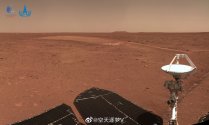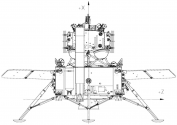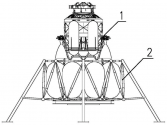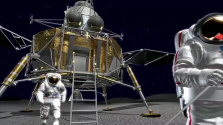You are using an out of date browser. It may not display this or other websites correctly.
You should upgrade or use an alternative browser.
You should upgrade or use an alternative browser.
China's Space Program News Thread
- Thread starter crazyinsane105
- Start date
- Status
- Not open for further replies.
The low resolution photos are taken by the throwaway wifi cameras. You can't compare it with the camera from curiosity.Why are China's space images always much lower resolution than the images provided by NASA? The images from their rovers are likewise very disappointing. It almost sems like it would be better if they didn't release the images at all because they suffer so much from the comparison. I can understand that they are much newer to the game, but is it really such a challenge to do imaging in space or on another planet? Is it not just a matter of using a larger sensor? Just asking out of curiosity...
You should have compared with the photos taken by Zhurong rover, like this one. Note this one is from internet, not naccessarily the best quality of the original.

China does have Tianwen in the orbit which acts as relay satellite. US have three orbiters, but that won't necessarily help to boost the bandwidth because the bottle neck is the rover's antenner.The problem is bandwidth. The US has orbiting satellites on Mars which can boost the signal of the rover and send it back to Earth. China does not. If you want a high resolution image it takes forever to send one.
The "problem" is comparing the wrong things, the selfie cam with the onboard cam of the rover.
The orbiter's selfie photos are of low quality, not because of bandwidth, but really because it is low quality camera.The Mars orbiter photos shared have poor resolution for a few reasons. It's not necessarily the camera and it has absolutely everything to do with transmission speeds as already mentioned. They could send back a 1000x higher clarity photo of the orbiter (provided the external camera is equipped for that like the many other cameras from this mission e.g. photos above). The problem would be do they want to send that photo and wait that long for one? It's just a photo of the orbiter. There are hundreds of super high resolution photos of the surface.
- The camera is one time throwaway, no point to waste a high value device.
- The camera was ejected from Tianwen, it was moving (for ever) away, taking photo when moving means blur. The only way to increase sharpness is to increase exposure speed and reduce aperture. That means increasing mass. A no-no for payload increase for its entertaining purpose.
- As the size/mass restraint, the camera does not have adjustable focus that produce sharp focus. It is infinite focus like a go-pro. This kind of camera will never be able to produce sharp image.
- The camera will quickly travel out of range of wifi, there is just a few seconds to take photos and transmitted back to the orbiter, so there is not much chance to have a lucky shot that is good.
Last edited:
These two pics are from ESA.
pic one via
pic two via :
China does have Tianwen in the orbit which acts as relay satellite. US have three orbiters, but that won't necessarily help to boost the bandwidth because the bottle neck is the rover's antenner.
The "problem" is comparing the wrong things, the selfie cam with the onboard cam of the rover.
Yes and I mentioned that.
The rover cam and the lander cam and the selfie cam are all high resolution.
The orbiter cam is unknown and that is the image being discussed. It is low resolution potentially due to bandwidth which is the ignored topic and potentially due to camera being purposefully low res because there doesn't even need to be a camera to provide a pointless shot. It could be either but people are using the low res shot (which could be due to several reasons) to imply all cameras are low res (orbiter, landers, rovers on moon and mars) which isn't the case at all. The Chinese moon and mars rovers and landers have had extremely high res photos provided to the public. The Chinese lunar orbiters from 10 years ago have provided the world's greatest resolution shots and mapped out the entire moon's surface.
The thing I wanted to bring up is the ignored and misunderstood bandwidth issue which applies sometimes.
China has built an artificial moon on Earth that simulates low-gravity conditions – the first of its kind. The facility is expected to play a key role in China’s future lunar missions.
Speaking on Tuesday, scientist Li Ruilin, from the China University of Mining and Technology, said that the artificial moon project in eastern city of Xuzhou is expected to be officially launched in the coming months.
Li described the program as “first of its kind in the world” and said it takes lunar simulation to a completely new level, as it can make gravity “disappear” and can “last as long as you want.”
The facility is made up of a vacuum chamber which houses a mini “moon” measuring 60cm (about two feet) in diameter. The moon-like landscape is made up of rocks and dust that are as light as those found on our Moon.
The landscape is supported by a magnetic field, like the Moon – where gravity is approximately one-sixth as strong as the gravity on Earth. Where the field is strong enough, certain light objects, such as a frog or chestnut, can levitate.
Li said the project is likely to play an important role in preparing for Chinese lunar operations, allowing scientists to test equipment and even prevent miscalculations that could prove costly on the Moon itself.
“Some experiments such as an impact test need just a few seconds [in the simulator],” said Li, adding that “others such as creep testing can take several days.”
The scientist noted that it could also be used to test whether 3D printing works on the Moon or whether lunar settlements would be able to survive.
“Some experiments conducted in the simulated environment can also give us some important clues, such as where to look for water trapped under the surface,” he said.
Li said that a number of technical innovations were needed to make the facility, noting that the magnetic forces needed to create the atmosphere are so strong that they can tear apart components like superconducting wires and render many metallic components useless.
He added that the facility, which was inspired by Andre Geim’s experiments to levitate a frog with a magnet, would be open to researchers from around the world.
Quickie
Colonel
China has built an artificial moon on Earth that simulates low-gravity conditions – the first of its kind. The facility is expected to play a key role in China’s future lunar missions.
Speaking on Tuesday, scientist Li Ruilin, from the China University of Mining and Technology, said that the artificial moon project in eastern city of Xuzhou is expected to be officially launched in the coming months.
Li described the program as “first of its kind in the world” and said it takes lunar simulation to a completely new level, as it can make gravity “disappear” and can “last as long as you want.”
The facility is made up of a vacuum chamber which houses a mini “moon” measuring 60cm (about two feet) in diameter. The moon-like landscape is made up of rocks and dust that are as light as those found on our Moon.
The landscape is supported by a magnetic field, like the Moon – where gravity is approximately one-sixth as strong as the gravity on Earth. Where the field is strong enough, certain light objects, such as a frog or chestnut, can levitate.
Li said the project is likely to play an important role in preparing for Chinese lunar operations, allowing scientists to test equipment and even prevent miscalculations that could prove costly on the Moon itself.
“Some experiments such as an impact test need just a few seconds [in the simulator],” said Li, adding that “others such as creep testing can take several days.”
The scientist noted that it could also be used to test whether 3D printing works on the Moon or whether lunar settlements would be able to survive.
“Some experiments conducted in the simulated environment can also give us some important clues, such as where to look for water trapped under the surface,” he said.
Li said that a number of technical innovations were needed to make the facility, noting that the magnetic forces needed to create the atmosphere are so strong that they can tear apart components like superconducting wires and render many metallic components useless.
He added that the facility, which was inspired by Andre Geim’s experiments to levitate a frog with a magnet, would be open to researchers from around the world.
".....Li described the program as “first of its kind in the world” and said it takes lunar simulation to a completely new level, as it can make gravity “disappear” and can “last as long as you want.”
The facility is made up of a vacuum chamber which houses a mini “moon” measuring 60cm (about two feet) in diameter. The moon-like landscape is made up of rocks and dust that are as light as those found on our Moon.
The landscape is supported by a magnetic field, like the Moon – where gravity is approximately one-sixth as strong as the gravity on Earth. Where the field is strong enough, certain light objects, such as a frog or chestnut, can levitate. .... "
I wonder how it works? How would a strong magnetic field counter the force of gravity when the non-metallic objects mentioned are involved?
- Status
- Not open for further replies.




